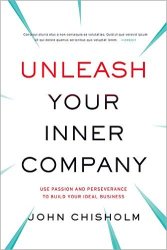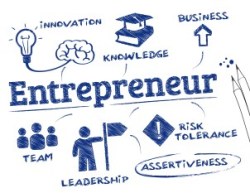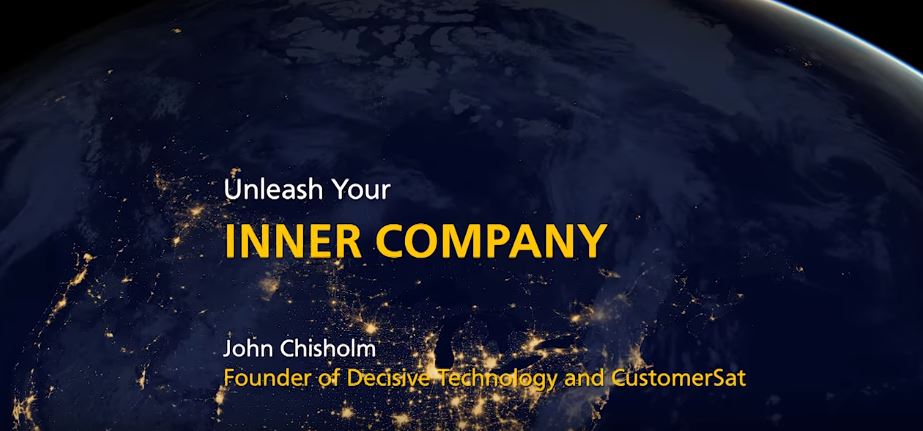 [This lecture is part 2 of the Entrepreneurship and Values Series and was recorded at Rockford University and sponsored by the Center for Ethics and Entrepreneurship.]
[This lecture is part 2 of the Entrepreneurship and Values Series and was recorded at Rockford University and sponsored by the Center for Ethics and Entrepreneurship.]
Unleash Your Inner Company by John Chisholm
Hello, I am John Chisholm and I am here at Rockford University in Rockford, Illinois at the Center for Ethics and Entrepreneurship to talk about how you can Unleash Your Inner Company! Why would you be interested in starting a company? Let me give you three reasons: freedom to do what you love; security for you and your family; and opportunities absolutely unique to you. No one else has your unique set of skills, knowledge and relationships. So, you have the potential to create a company that no one else can.
So, where do you start? Start with what you are passionate about. It could be a sport, a field of study, your family, an organization, or anything that you have deep and strong feelings about. I’ve been a math geek since I was in junior high school, so starting a company involving analyzing data has been natural for me. But the good news is that anyone can become passionate about something. Just start by learning about it, going online, using Wikipedia, meeting up people who are experts in it, and going deeper and deeper. The more you learn, the more engaging the subject becomes, and the more passionate that you become about it.
The most powerful combination is passion with perseverance. Those can either go separately or together. Passion without perseverance is a fleeting fancy. Perseverance without passion is drudgery. But the combination of the two, which I call “flow”, builds on each other and keeps you going the long distance. Passion and perseverance are so important because: 1) they give you the staying power to break through obstacles or finding ways around them, and 2) they give your curiosity to discover opportunities before others do.
In my second company, CustomerSat, we had, during the dot-com bust, to lay off 40 percent of our workforce, cut back salaries by 20 percent, factor receivables to make payroll, and move to more modest, smaller offices. All hard and humbling things for a company to do. But we made it through. Now, I don’t think it was because we were smarter than other companies during the dot-com bust. But I do think we cared more about our products, our services, our customers, and each other — our employees. And we stuck with it longer. And that combination of passion and perseverance, I think, is what got us through.
Now, I don’t think it was because we were smarter than other companies during the dot-com bust. But I do think we cared more about our products, our services, our customers, and each other — our employees. And we stuck with it longer. And that combination of passion and perseverance, I think, is what got us through.
Within areas that you are passionate about, it only takes two things to start a business: a customer need, and an advantage for addressing that need. Your advantages are your resources relative to others who are addressing the same need, namely, your competitors.
So, let’s start with the needs. Millions of customer needs surround us all the time. Some people say that all the customer needs have already been satisfied. Nonsense. Every time there is a new solution, that creates new needs and also enables new solutions in three ways. One, the solutions themselves can be improved. Two, the providers of those solutions have needs. And three, the solutions create needs around them. So, there has never been more opportunity to satisfy customer needs than today.
Here is one way to think of lots of customer needs. Think of any product or service you currently use, say, running shoes. Okay, what are limitations of running shoes? Well, I can think of three. They start to smell after you’ve worn them many times. You can’t easily change the shoelaces to match your outfit or shirt. And they don’t tell you how far you’ve run or how long you’ve run. Great. Those are three customer needs. Are they real? Do they already have solutions? Well, for that, we need to do some research. Go online, talk to people, see if many other people have that need and see if there are already solutions to those needs. If there are solutions, great, those solutions themselves may have limitations and suggest new needs around them. And if there aren’t any solutions that you can find, great, you’ve found a need for which there is a solution waiting to be found. And that’s an opportunity to use creativity. For example, coming up with a shoelaces that can snap on and off of your shoes in different colors and therefore match your outfit. So, if you continue this process, you can see that you can create a tree of customer needs and solutions from a single product. There is an essentially infinite number of such needs and solutions that you can generate. Your job is to figure out which ones are real and later, which ones are the best fits for your advantages.
After you’ve come up with those customer needs, I want you to think big: supersize them. Rather than a single kiosk, how about a chain of kiosks across your city? Rather than improving the performance of one mobile application, how about tools to improve the performance of all mobile applications? There are two ways to up-size or supersize your customer need. One is by broadening the need and two is by expanding the customer set. Let’s take a look at 2 Degrees Food and see their vision for expanding their customer need that they satisfy. On this chart, customer sets are on the vertical axis and the needs are on the horizon axis. So they start with “1” in the lower left and gradually expand to “11”.

Now, let’s turn to your advantages. Remember your advantages are your resources relative to others satisfying the same need — your competitors. Your resources and advantages fall into seven categories. I use the acronym S.T.A.A.R.R.S. to remember them: Skills, Technologies, Assets & Achievements, Relationships & Reputation, and Strengths (as in inner Strengths). Make a table of your S.T.A.A.R.R.S. like the one shown here. The different resources in that table serve different purposes. The Skills and Technologies will be most important in choosing between one customer need and another. The Financial and Physical Assets tend to apply more equally to all customer needs. And the Accomplishments, Relationships, Reputation and Strengths tend to build your self-confidence, again, for addressing any customer need.
I remember how much easier my life became when Dickey Singh joined my second company as chief technology officer. He quickly took on responsibility for software development, QA (quality assurance), web operations, IT and tech support, freeing me up to focus on what I like best to do best: customers, sales, marketing, and products. Your likelihood of success is more than double if you can find the right co-founder, somebody whose skills are complementary to yours, who shares your work ethic, whom you trust, and who broadly shares your same vision of where the company is going. You also start getting experience dealing with the issues that will be most important to your company as you grow: consensus building, conflict resolution and creating a positive working environment. So, 1 + 1 = 3.
One of your key resources will be funding. In my experience, 90 percent of companies waste money trying to raise money before they are ready. The best time is right after your company has reached a significant milestone that reduces investor risk. If you have revenue, that eliminates the risk that you get a customers. If you have positive cash flow, that will eliminate the risk that you can get revenue. By waiting until you reach one of these milestones, the deal comes together more quickly, you are in a stronger negotiating position, and you can get back to running the company, which is what you really want to be doing.
Your mind is one of your key resources. The mind is like an iceberg, consciously aware of about only 20 percent of ideas that come into our mind. 80 percent come through our unconscious mind and we are not even aware of these ideas and messages. So we have to protect the mind from messages that can be harmful. The most dangerous ones are the ones that come from us. Negative thoughts and messages, if repeated, the unconscious mind will accept as fact, and they will turn into reality. So, for any negative thought like these that might creep into your mind, think of a specific incident, no matter how small, when you did the opposite. If it was a party, you put everyone of these. If it was a game, you were the star of the show. Keep these positive thoughts in mind where you can quickly recall them. This will help make them reality.
When we criticize or complain, endorphins flow to our brains and, for a brief moment, we feel superior. But after that moment, the endorphins fade away and we lose that sense of well-being and superiority, and the people around us have been demoralized. The outcome of this can only be negative. Many other approaches are better. Ask questions, articulate consequences, celebrate the good. Try these instead.
When I was in mid-30s, I accepted the fact that I am gay. Most people wouldn’t feel this is a strength. I disagree. For me, it has been an advantage in three ways. 1) It wasn’t socially acceptable to be openly gay when I was growing up, and so the time I might have put into dating, I put into sports and school and career. Twenty years later, thirty years later, I am hugely enjoying the benefit of that early investment. 2) I am not a minority in any sense that I can think of other than being gay. And so, it has sensitized me to what it is like to be a minority and some of the challenges. 3) When you are growing up and you are gay, you know, with certainty, that a lot of the assumptions that people routinely make are wrong. For example, that guys are attracted to gals and vice-versa. So, I think it has helped me think outside of the box and challenge the status quo, and that has helped me in my career.
Similarly, if there is some aspect of yourself that you genuinely cannot change, find a way to view it as a strength. I urge you to set the bar very high. Don’t use this as an excuse to accept some aspect of yourself that you can change and would like to change. But if you genuinely cannot change it, and if you can find a way to view it as a strength, it will become a strength and it will be hugely empowering for you as it was for me.
Just as reminding ourselves of our strengths makes us stronger, so does reminding other people around us of their strengths make them stronger. Even if you see just a glimmer of courage or perseverance or good judgment in other person, letting them see that, being as specific as possible, helps build those qualities in them. People want to be surrounded by other people who built them up. So this also attracts good people to you and elevates you to a position of leadership among them.
To make any slide more engaging, add a kitten, cat, or puppy. But this isn’t about the cat. Do you see the point on the carpet next to the cat? I cannot raise up that point very far unless I also lift up all the points around it. Well, we are all like the points on that carpet, aren’t we?
We’ve come up with customer needs in areas we’re passionate about, and separately we have inventoried our resources. Those resources themselves suggest additional customer needs. In this case, the combinations of different resources like medical experience, chemistry background, and knowledge of our hometown suggest two additional customer needs that we can add to our list.
Look for novel combinations of the technologies that you know about. If two of them are new and growing rapidly, the intersection of them will be small, but will grow even faster. If you can meaningfully combine three of them, so much the better. These intersections harbor particular good entrepreneurial opportunities. My first company, Decisive Technology, combined surveys with the internet. My second company added analytics, business rules, and case management.
 HP, IBM, Dell all run Windows. Each one is better than the other in some fashion: a 20 percent larger screen, 20 percent faster processor, or 30 percent more storage capacity. In contrast, Apple has long been different. Better for publishing audio and video. As a result, over the last decade, Apple has gradually gained market share against Windows and today is the most valuable company in the world. “Better” means that you have to address existing competitors head on. Instead, be different in a way that is valuable by some sub-sector of customers. You will have more time and space to get established. And as your customers grow and buy from you again and again and recommend you to their friends and colleagues, you will grow with them. So, different is better than better.
HP, IBM, Dell all run Windows. Each one is better than the other in some fashion: a 20 percent larger screen, 20 percent faster processor, or 30 percent more storage capacity. In contrast, Apple has long been different. Better for publishing audio and video. As a result, over the last decade, Apple has gradually gained market share against Windows and today is the most valuable company in the world. “Better” means that you have to address existing competitors head on. Instead, be different in a way that is valuable by some sub-sector of customers. You will have more time and space to get established. And as your customers grow and buy from you again and again and recommend you to their friends and colleagues, you will grow with them. So, different is better than better.
How do we find the best fit now between those customers needs and your resources and advantages? Well, here are two different ways. First, make a copy of your S.T.A.A.R.R.S. chart for each customer need and circle the resources on that chart that were advantages for each of those customer needs. The customer needs that make the best use of your advantages are the ones where you are most likely to be successful. Another way to do it is to create a big table like this with customer needs down the vertical axis and advantages across the horizontal axis. Also, have a separate column for passion. And then fill in the chart using any rating scale you like and then stand back and look at it. Add your comments and thoughts as well. In this example, I used check marks. So, look for the customer needs for which you have the most checkmarks. Those are the ones that make the best of your advantages and where you are most likely to be successful.
You want to design your business to generate increasing profit and revenue for each dollar of capital invested. That’s scalability. In this example, the green company is much more scalable than the red company, and a much more attractive opportunity to potential investors. Probably, it’s more streamlined and automated than the red company. Any company can be made more scalable. Here are some ideas. Rather than have your staff configure your products and services, let your customers do it themselves by filling out online forms. Rather than having just an outbound sales staff, use telesales and online sales when possible. Rather than dealing with invoices and purchase orders, use credit cards and debit cards whenever possible. Rather than have to sell annual renewals, have evergreen contracts that renew automatically unless the customer cancels them or, in addition to having a large customer service and support organization, let your customers support themselves and each other through online communities and reward them and recognize them for doing so. All of these things will help make your business more scalable.
After that, it’s a process of getting more input and feedback, further strengthening your advantages and ever more closely aligning and refining the fit between customer needs into advantages. This may take months. The product or service that you’ve come up with maybe very different from the one you started with, that’s okay, that’s the norm, that’s creative destruction happening within your own company. Better for you to do it than somebody else.
Finally, let’s talk briefly about business ethics. When we hear about business ethics, what do we usually hear about it? Well, predatory behavior on the one hand. Theft, false advertisement, corruption, that’s bad; and philanthropic behavior, helping hurricane victims or the hungry in Africa, that’s good. Well, I don’t disagree with either of those, but I don’t think that’s the whole story or even the most important part of the story. I am going to make the case to you right now that entrepreneurship is among the most ethical career choices that you can make.
Let’s first consider the individual virtues and values that successful entrepreneurship requires and develops. Finding a new idea take creativity, diligence, and rationality. Striking out on your own takes courage. Testing and refining ideas and dropping an idea for which there is not customer demand takes intellectual honesty. And your customers and employees have the option of going elsewhere, so why should they come to you? You have to treat them honestly and fairly, and that may take creativity and flexibility and diligence on your part because your resources will be less than established companies.
Now, let’s turn to the social benefits. It is impossible to be successful in entrepreneurship without making the world a better place. That means creating more choice, more innovation, lower cost, or some combination of them. Again, if you don’t provide these, your customers will go elsewhere. Similarly, you need to create win-wins for all of your stakeholders — employees, customers, partners and investors — or they will go elsewhere, too.
Again, if you don’t provide these, your customers will go elsewhere. Similarly, you need to create win-wins for all of your stakeholders — employees, customers, partners and investors — or they will go elsewhere, too.
If we stand back and look at the result of ten of millions of entrepreneurs around the world, all of them making the world a better place, developing products and services, all of them innovating and creating win-wins, they are improving standards of living and quality of life around the world. And, incidentally, guess what is funding that philanthropy primarily? You guessed it: entrepreneurship. Given all of these benefits, I rest my case that entrepreneurship is the most ethical thing or among the most ethical things you can do.
We’ve talked about passion and perseverance, customer needs, resources and advantages, psychology and the ethics of entrepreneurship. Unleashing your inner company, no matter what size, will give you the freedom to do what you love, give you security for you and your family, and endow you with the self-confidence that you will enjoy for the rest of your life. You don’t need permission, you don’t need credentials. You just need to do it, so go have fun doing it.
Thank you.
[The video of this lecture by John Chisholm follows.]
[Read more about John Chisholm at his website and about his book Unleash Your Inner Company here.]
